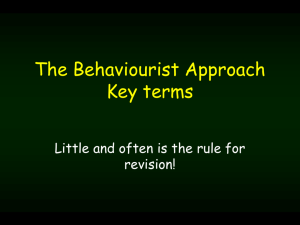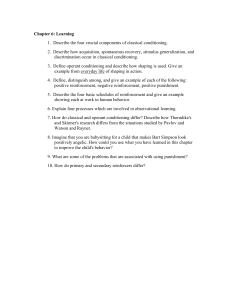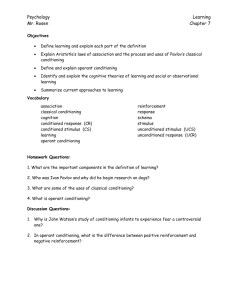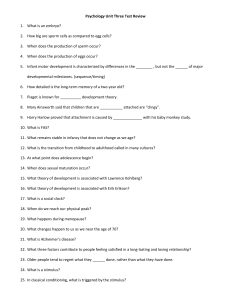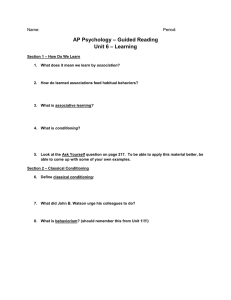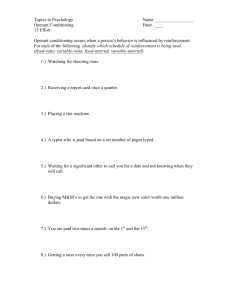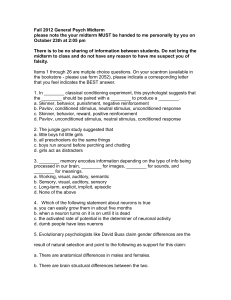learned
advertisement
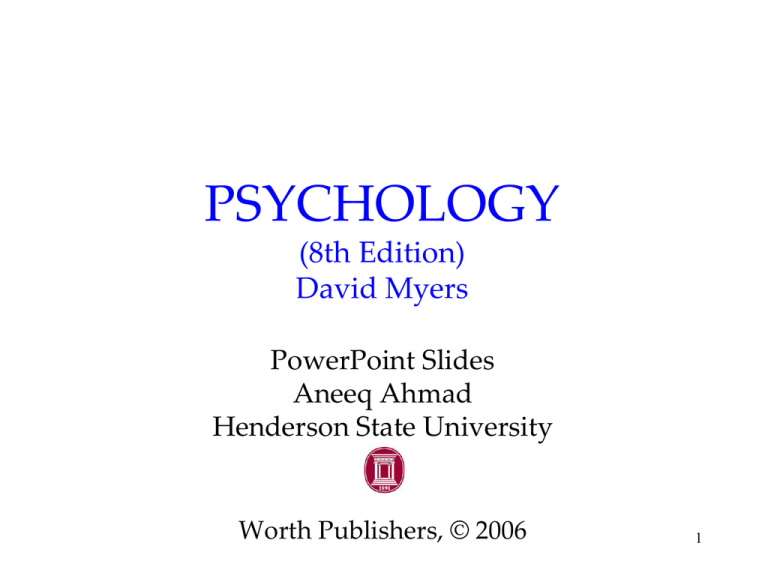
PSYCHOLOGY (8th Edition) David Myers PowerPoint Slides Aneeq Ahmad Henderson State University Worth Publishers, © 2006 1 Learning Chapter 8 2 Learning How Do We Learn? Classical Conditioning Pavlov’s Experiments Extending Pavlov’s Understanding Pavlov’s Legacy 3 Learning Operant Conditioning Skinner’s Experiments Extending Skinner’s Understanding Skinner’s Legacy Contrasting Classical & Operant Conditioning 4 Learning Learning by Observation Bandura’s Experiments Applications of Observational Learning 5 ADAPTATION • Adaptation is adjusting to a changed environment • Development involves adapting to increasingly complex environments, using knowledge gained from experience • Instinctive behavior is adaptive (ex:imprinting, others?) 6 Definition Learning is a relatively permanent change in an organism’s behavior due to experience. Learning is more flexible in comparison to the genetically-programmed behaviors of Chinooks, for example. 7 HABITUATION • Habituation is a type of learning: adapting to stimuli that do not change • It is NOT because the organism has learned about a relationship or an association • Opponent Process Theory by Richard Solomon is based on habituation 8 OPPONENT PROCESS THEORY • Habituation to repeated stimuli is the result of two interacting processes: – A Process = fixed automatic, emotional, unlearned response – B Process = initially slower reaction, triggered by the A Process; counter effect of A Process – Explains emotions, drug dependency 9 How Do We Learn? EXPERIENCE IS THE KEY TO LEARNING We learn by association. Our minds naturally connect events that occur in sequence. 2000 years ago, Aristotle suggested this law of association. Then 200 years ago Locke and Hume reiterated this law. 10 Stimulus-Stimulus Learning Learning to associate one stimulus with another (basis of Classical Conditioning). 11 Stimulus-Stimulus Learning Learning to associate one stimulus with another. 12 Response-Consequence Learning Learning to associate a response with a consequence (basis of Operant Conditioning). 13 Response-Consequence Learning Learning to associate a response with a consequence. 14 Classical Conditioning Sovfoto Ideas of classical conditioning originate from old philosophical theories. However, it was the Russian physiologist Ivan Pavlov who elucidated classical conditioning. His work provided a basis for later behaviorists like John Watson and B. F. Skinner. Ivan Pavlov (1849-1936) 15 BEHAVIORISM • Behaviorism is a view that Psychology should: – Be an objective science (currently accepted) – Study behavior without reference to mental processes, therefore a rejection of introspection (currently not accepted) 16 Pavlov’s Experiments Before conditioning, food (Unconditioned Stimulus, US) produces salivation (Unconditioned Response, UR). However, the tone (neutral stimulus) does not. 17 Pavlov’s Experiments During conditioning, the neutral stimulus (tone) and the US (food) are paired, resulting in salivation (UR). After conditioning, the neutral stimulus (now Conditioned Stimulus, CS) elicits salivation (now Conditioned Response, CR) 18 CLASSICAL CONDITIONING • TERMINOLOGY – – – – Conditioned = Learned Unconditioned = Unlearned Stimulus = Causes a response Response = Behavioral reaction to stimulus • BASIC COMPONENTS: – – – – Natural reflex (automatic, involuntary) Neutral stimulus Association of stimuli Timing 19 ACTIVITY—spray bottle • What behavior (response) was demonstrated? • What action (stimulus) led to the behavior? • Was the behavior voluntary or involuntary? Did this change? • What word (neutral stimulus) became associated with the stimulus? • How long did this take? • What might cause the response to disappear? 20 Acquisition Acquisition is the initial stage in classical conditioning in which an association between a neutral stimulus and an unconditioned stimulus takes place. 1. In most cases, for conditioning to occur, the neutral stimulus needs to come before the unconditioned stimulus. 2. The time in between the two stimuli should be about half a second. 21 Acquisition The CS needs to come half a second before the US for acquisition to occur. 22 Extinction When the US (food) does not follow the CS (tone), CR (salivation) begins to decrease and eventually causes extinction. Example? 23 RECONDITIONING THE QUICK RELEARNING OF A CONDITIONED RESPONSE AFTER EXTINCTION Example? 24 Spontaneous Recovery After a rest period, an extinguished CR (salivation) spontaneously recovers, but if the CS (tone) persists alone, the CR becomes extinct again. Example? 25 Stimulus Generalization Tendency to respond to stimuli similar to the CS is called generalization. Pavlov conditioned the dog’s salivation (CR) by using miniature vibrators (CS) on the thigh. When he subsequently stimulated other parts of the dog’s body, salivation dropped. 26 EXTENDING PAVLOV • John Watson, another Behaviorist, worked with Baby Albert (Reading and Questions) • Video: Phobias (define) and Wolpe’s systematic desensitization (define) treatment is based on CC • Various Behavioral therapies - what techniques did you see in the video?) • Some medical treatments are based on classically conditioning immune system response (placebos) 27 Applications of Classical Conditioning Watson used classical conditioning procedures to develop advertising campaigns for a number of organizations, including Maxwell House, making the “coffee break” an American custom. Brown Brothers Baby Albert Activity and Worksheet The Office Video clip John B. Watson 28 Stimulus Discrimination Discrimination is the learned ability to distinguish between a conditioned stimulus and other stimuli that do not signal an unconditioned stimulus. Example? 29 SECOND ORDER CONDITIONING • ALSO referred to as Higher Order Conditioning • When a conditioned stimulus acts like an unconditioned stimulus, creating conditioned stimuli out of events associated with it. • Example? – – – – Money Good Grades A pleasant tone of voice A word of praise • Very important adaptive characteristic of cc in preparing organism for life threatening events 30 SECOND ORDER CONDITIONING • Conditioned reinforcers, also known as, secondary reinforcers, are learned. • They get their power through association with primary reinforcers. • For example: – Our lives are filled with potential secondary reinforcers each of which may have been linked with more basic rewards. Secondary reinforcers greatly enhance our ability to influence one another. 31 Extending Pavlov’s Understanding Pavlov and Watson considered consciousness, or mind, unfit for the scientific study of psychology. However, they underestimated the importance of cognitive processes and biological constraints. 32 Cognitive Processes Early behaviorists believed that learned behaviors of various animals could be reduced to mindless mechanisms. However, later behaviorists suggested that animals learn the predictability of a stimulus, meaning they learn expectancy or awareness of a stimulus (Rescorla, 1988). 33 Cognitive Processes This principle helps explain why classical conditioning treatments that ignore cognition often have limited success. In classical conditioning, especially with humans, it is not only the simple CS-US association but also the thought that counts. 34 TASTE AVERSION ACTIVITY: SOUP Use a 9 point scale (1 = dislike extremely) • 1. Stirred by a thoroughly washed, used flyswatter. • 2. Flyswatter is brand new. • 3. Thoroughly washed but used comb • 4. Thoroughly washed, used dog bowl 35 TASTE AVERSION: FAVORITE COOKIE • • • • 5. 6. 7. 8. Dropped it on the grass first? A waiter had taken a bite first? An acquaintance had taken a bite first? A good friend had taken a bite first? 36 TASTE AVERSION • The association principle is everything when it comes to food. Rozin’s results: • 1. 82% a 4 or less (clean flyswatter) • 2. 58% disliked (brand new flyswatter) • 3. 76% disliked (clean, used comb) • 4. 71% disliked (washed dog bowl) 37 Taste Aversion • • • • 5. 6. 7. 8. Only 34% would pass up (grass) 84% reject (waiter) 31% reject (acquaintance) Just 16% refuse (friend) 38 Taste Aversion and Biological Predispositions • Have you ever gotten sick after eating a particular food? • How did you feel about/react to the food after the incident? • How strong was this feeling/reaction? • How long did the feeling/reaction last? 39 Biological Predispositions Pavlov and Watson believed that laws of learning were similar for all animals. Therefore, a pigeon and a person do not differ in their learning. However, behaviorists later suggested that learning is constrained by an animal’s biology. 40 Biological Predispositions Courtesy of John Garcia Garcia showed that the duration between the CS and the US may be long (hours), but yet result in conditioning. A biologically adaptive CS (taste) led to conditioning and not to others (light or sound). John Garcia 41 Biological Predispositions Even humans can develop classically to conditioned nausea. 42 Biological Predispositions *Important Point*--Learning enables animals to adapt to their environments. This adaptation shows why animals would be responsive to stimuli that announce significant events, such as food or pain. However, behaviorists later suggested that learning is constrained by an animal’s biology. 43 Pavlov’s Legacy Pavlov’s greatest contribution to psychology is isolating elementary behaviors from more complex ones through objective scientific procedures. Ivan Pavlov (1849-1936) 44 Applications of Classical Conditioning 1. Alcoholics may be conditioned (aversively) by reversing their positive-associations with alcohol. 2. Through classical conditioning, a drug (plus its taste) that affects the immune response may cause the taste of the drug to invoke the immune response. 45 Anxiety and Phobias video 46 SHAPING EXERCISE • How did we get the subject to perform the behavior? • What if we had waited until he/she was able to perform the behavior perfectly before we reinforced it? • Shaping: reinforcing successive approximations 47 Operant & Classical Conditioning 1. Classical conditioning forms associations between stimuli (CS and US). Operant conditioning, on the other hand, forms an association between behaviors and the resulting events (consequences). 48 Operant & Classical Conditioning 2. Classical conditioning involves respondent behavior that occurs as an automatic response to a certain stimulus. Operant conditioning involves operant behavior, a behavior that operates on the environment, producing rewarding or punishing stimuli. 49 Skinner’s Experiments Skinner’s experiments extend Thorndike’s thinking, especially his law of effect. This law states that rewarded behavior is likely to occur again. Yale University Library 50 Using Thorndike's law of effect as a starting point, Skinner developed the Operant chamber, or the Skinner box, to study operant conditioning. Walter Dawn/ Photo Researchers, Inc. 51 From The Essentials of Conditioning and Learning, 3rd Edition by Michael P. Domjan, 2005. Used with permission by Thomson Learning, Wadsworth Division Operant Chamber Operant Chamber The operant chamber, or Skinner box, comes with a bar or key that an animal manipulates to obtain a reinforcer like food or water. The bar or key is connected to devices that record the animal’s response. 52 Shaping Shaping is the operant conditioning procedure in which reinforcers guide behavior towards the desired target behavior through successive approximations (hot/cold activity). Fred Bavendam/ Peter Arnold, Inc. Khamis Ramadhan/ Panapress/ Getty Images A rat shaped to sniff mines. A manatee shaped to discriminate objects of different shapes, colors and sizes. 53 SHAPING • GIVE AN EXAMPLE OF UNINTENDED SHAPING. • CHAINING • Linking in a sequence of several different reinforced behaviors 54 Types of Reinforcers Any event that strengthens the behavior it follows is a reinforcer. A heat lamp positively reinforces a meerkat’s behavior in the cold. Reuters/ Corbis 55 Analyze Charts of Reinforcement • The Big Bang Theory Video Clip 56 Critical Thinking Exercises • Positive and Negative Reinforcement Activities 57 NEGATIVE REINFORCEMENT • Remember: the behavior increases due to the removal or the end of an aversive stimuli • Two types: – Escape conditioning: organism learns to make a response to end the negative reinforcement – Avoidance conditioning: organism learns to avoid the negative reinforcer. 58 • Avoidance conditioning (continued): – A powerful influence on everyday behavior Example? – Maintains phobias etc. because the response is reinforced by the reduction of the fear 59 Primary & Secondary Reinforcers 1. Primary Reinforcer: An innately reinforcing stimulus like food or drink. 2. Conditioned Reinforcer (sometimes called a secondary reinforcer): A learned reinforcer that gets its reinforcing power through association with the primary reinforcer. Example? 60 Immediate & Delayed Reinforcers 1. Immediate Reinforcer: A reinforcer that occurs instantly after a behavior. A rat gets a food pellet for a bar press. 2. Delayed Reinforcer: A reinforcer that is delayed in time for a certain behavior. A paycheck that comes at the end of a week. We may be inclined to engage in small immediate reinforcers (watching TV) rather than large delayed reinforcers (getting an A in a course) which require consistent study. 61 Reinforcement Schedules 1. Continuous Reinforcement: Reinforces the desired response each time it occurs. Learning is very rapid but extinction is also rapid. 2. Partial Reinforcement: Reinforces a response only part of the time. Though this results in slower acquisition in the beginning, it shows greater resistance to extinction later on. You may need to start with a continuous schedule. 62 PARTIAL OR INTERMITTENT REINFORCEMENT TERMS • • • • Fixed - Never changing Variable - Changing Interval - Having to do with time Ratio - Having to do with behavior or performance 63 Partial or Intermittent Reinforcement Schedules 1. Fixed-ratio schedule: Reinforces a response only after a specified number of responses. e.g., piecework pay. 2. Variable-ratio schedule: Reinforces a response after an unpredictable number of responses. This is hard to extinguish because of the unpredictability. (e.g., behaviors like gambling, fishing.) 64 Interval Schedules 1. Fixed-interval schedule: Reinforces a response only after a specified time has elapsed. (e.g., preparing for an exam only when the exam draws close.) Produces a scalloping response 2. Variable-interval schedule: Reinforces a response at unpredictable time intervals, which produces slow, steady responses. (e.g., pop quiz.) 65 Schedules of Reinforcement 66 Analyze Schedules of Reinforcement 67 IDENTIFY THE SCHEDULE OF REINFORCEMENT: FI, VI, FR, VR • 1. Paid 10 dollars for every 20 puzzles solved • 2. Playing Bingo • 3. Child who likes to hear theme music from Jeopardy every night at 7 pm • 4. Waiting for a sunny day to go to the beach • Group Practice with hand-out 16-7 68 Punishment An aversive event that decreases the behavior it follows. 69 Analyze Punishment Charts 70 PUNISHMENT • REMEMBER: • POSITIVE IS TO ADD • NEGATIVE IS TO SUBTRACT • DO NOT THINK IN TERMS OF GOOD AND BAD! 71 Punishment Examples • Come up with an example of Positive Punishment – For a toddler – For a teenager – For an adult • Come up with an example of Negative Punishment – For a toddler – For a teenager – For an adult Write down about time when you were punished. What were the immediate and lasting effects? Did the punishment fit the crime? Did the punishment decrease the behavior? 72 Punishment Although there may be some justification for occasional punishment (Larzelaere & Baumrind, 2002), it usually leads to negative effects. 1. 2. 3. 4. Results in unwanted side effect such as fear. Conveys no information to the organism. Justifies pain to others. Causes unwanted behaviors to reappear in its absence. 5. Causes aggression towards the agent. 6. Causes one unwanted behavior to appear in place of another. 73 PUNISHMENT • 7. Does not erase an undesirable habit, it merely suppresses it • 8. Ineffective unless applied immediately after and each time • 9. Does not specify correct behavior 74 GUIDELINES IN USING PUNISHMENT • Specify why • Concentrate on behavior not the person • Should be immediate and strong enough without being too strong • Be careful of escalation (if punishment is not given early enough, bad behavior escalates • Combine with other behavior 75 Super Nanny Episode 76 Extending Skinner’s Understanding Skinner believed in inner thought processes and biological underpinnings, but many psychologists criticize him for discounting them. 77 Cognition & Operant Conditioning Evidence of cognitive processes during operant learning comes from rats during a maze exploration in which they navigate the maze without an obvious reward. Rats seem to develop cognitive maps, or mental representations, of the layout of the maze (environment). 78 COGNITIVE PROCESSES • Learned helplessness (Martin Seligman) • Insight (Sultan’s Aha! Experience) • Premack Principle (hierarchy of behavioral preferences) • Disequalibrium Hypothesis (What you’ve been prevented from will increase as a reinforcer) “Reverse psychology!” 79 Latent Learning Such cognitive maps are based on latent learning, which becomes apparent when an incentive is given (Tolman & Honzik, 1930). 80 Motivation Intrinsic Motivation: The desire to perform a behavior for its own sake. Extrinsic Motivation: The desire to perform a behavior due to promised rewards or threats of punishments. 81 Biological Predisposition Photo: Bob Bailey Biological constraints predispose organisms to learn associations that are naturally adaptive. Breland and Breland (1961) showed that animals drift (instinctive drift) towards their biologically predisposed instinctive behaviors. Marian Breland Bailey 82 Skinner’s Legacy Skinner argued that behaviors were shaped by external influences instead of inner thoughts and feelings. Critics argued that Skinner dehumanized people by neglecting their free will. Falk/ Photo Researchers, Inc . 83 Applications of Operant Conditioning Skinner introduced the concept of teaching machines that shape learning in small steps and provide reinforcements for correct rewards. LWA-JDL/ Corbis In School 84 Applications of Operant Conditioning Reinforcement principles can enhance athletic performance. In Sports 85 Applications of Operant Conditioning Reinforcers affect productivity. Many companies now allow employees to share profits and participate in company ownership. At work 86 Applications of Operant Conditioning In children, reinforcing good behavior increases the occurrence of these behaviors. Ignoring unwanted behavior decreases their occurrence. PARENTING: Reinforce correct behavior, target specific behavior Ignore whining When behavior occurs, explain and give a time out. 87 Applications of Operant Conditioning • • • • Culturally approved gender roles Discriminative stimuli (insomnia) Socialization Others? 88 Operant vs. Classical Conditioning 89 Learning by Observation © Herb Terrace Higher animals, especially humans, learn through observing and imitating others. ©Herb Terrace The monkey on the right imitates the monkey on the left in touching the pictures in a certain order to obtain a reward. 90 Reprinted with permission from the American Association for the Advancement of Science, Subiaul et al., Science 305: 407-410 (2004) © 2004 AAAS. Mirror Neurons Neuroscientists discovered mirror neurons in the brains of animals and humans that are active during observational learning. 91 Learning by observation begins early in life. This 14-month-old child imitates the adult on TV in pulling a toy apart. Meltzoff, A.N. (1998). Imitation of televised models by infants. Child Development, 59 1221-1229. Photos Courtesy of A.N. Meltzoff and M. Hanuk. Imitation Onset 92 Bandura's Bobo doll study (1961) indicated that individuals (children) learn through imitating others who receive rewards and punishments. Courtesy of Albert Bandura, Stanford University Bandura's Experiments 93 Applications of Observational Learning Unfortunately, Bandura’s studies show that antisocial models (family, neighborhood or TV) may have antisocial effects. 94 Positive Observational Learning Bob Daemmrich/ The Image Works Fortunately, prosocial (positive, helpful) models may have prosocial effects. 95 Gentile et al., (2004) shows that children in elementary school who are exposed to violent television, videos, and video games express increased aggression. Ron Chapple/ Taxi/ Getty Images Television and Observational Learning 96 Modeling Violence Children modeling after pro wrestlers Glassman/ The Image Works Bob Daemmrich/ The Image Works Research shows that viewing media violence leads to an increased expression of aggression. 97 Observational Learning Cube Exercise in groups 98
